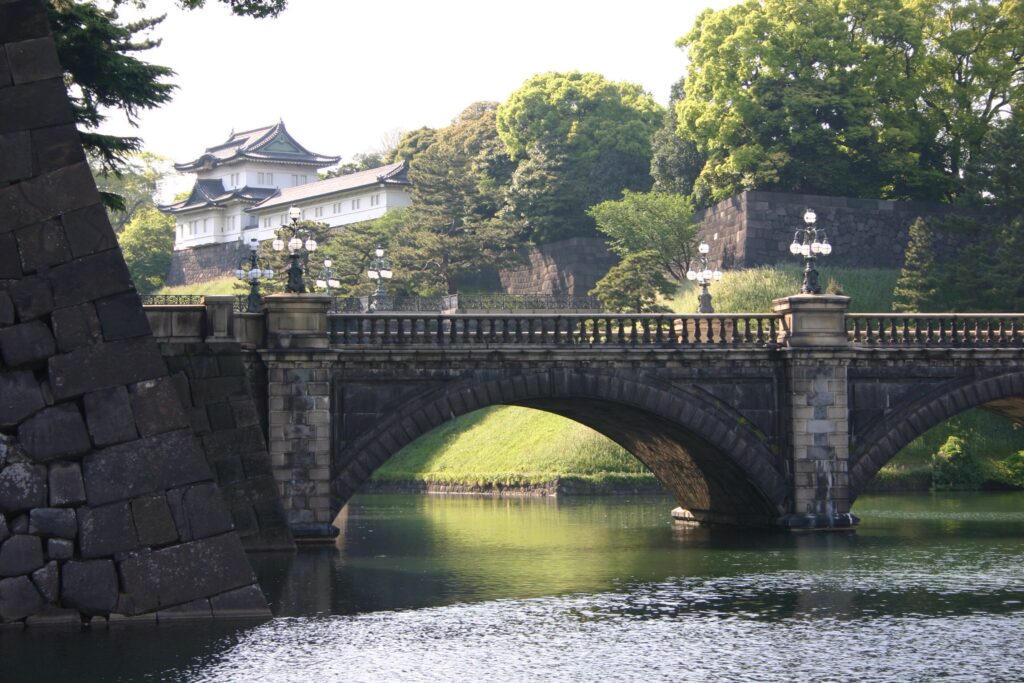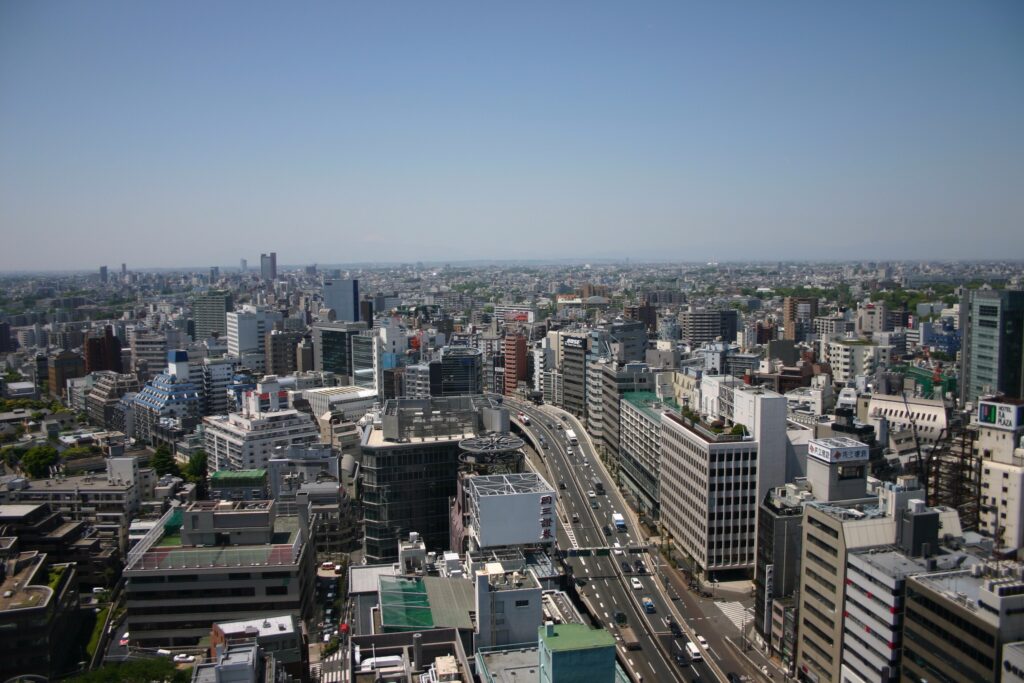
The lucky ones on the left side of the plane get the picture-perfect view of Mount Fuji as we make our silent way across the skies to Narita airport. I am on the right hand side of the aircraft, awakening lazily to the blue sky merging easily with the deeper blue of the Pacific Ocean. My view is not as dramatic, but nevertheless it’s an inspiring one, and sunrise is a fitting time to be arriving in Japan.
It’s clear well before we touch down that I am arriving in a country different to anywhere I have been before. As we cross the coastline, the whole countryside gives the impression of a recent devastating flood. But in fact it’s the paddy-fields of Kujukuri-hama, like a giant patchwork of silvered mirrors laid end-to-end across the landscape, glittering in the early morning sun.
Narita is a good sixty kilometres from Tokyo, so I commence my first challenge – how to get to my hotel. New to Japan, can’t speak the language, semi-comatose from the overnight flight, and outnumbered one million to one by Japanese. Lost and confused. I think I am probably being secretly filmed and will be the agonised subject of some hilarious Japanese game show to be syndicated to TV channels around the world.
I have been given very straight-forward instructions: “Come out of the airport and take the Shibuya limousine bus, which will drop you at your hotel.”
It sounded simple when I read it in the e-mail. But here at the airport everything is suddenly very Japanese, unfamiliar, and confusing. What is a limousine bus, for example. Is it a limousine or is it a bus? Or is it some kind of stretched low Clapham Omnibus with black windows, a showy curved TV aerial and yuppies waving bottles of champagne out of the window? And how does ‘Shibuya’ look in Japanese, how do you pronounce it, and why am I the only person at Tokyo airport who doesn’t have a clear and determined view of where they are going?
I find a pretty Japanese lady at the information desk and I am relieved to learn that ‘Shibuya’ is pronounced ‘Shibuya’, and that a ‘limousine bus’ is a bus. But I feel cheated to find, after a desperate sprint across the concourse that if I had found the pretty lady one minute earlier I would have just caught the limousine bus rather than just missed it. The next one is in three hours time. I return to the information lady, now my closest friend in Japan. She will know what to do.
She tells me to take the train. She says it quite casually, but I have already had a glimpse of the terrifying Tokyo train system map. An intricate woven plaid of railways with so many lines they ran out of colours, impossible to tell the subtle difference between the greens of the Namboku, Chiyoda, and Shinjuku Lines. I thought I was heading for Tokyo, but she says I must take the train to somewhere called Shinagawa, and then catch something called the ‘JR’ line, whatever that is.
So I go to the train station, just down a short escalator followed by ten dangerous metres across a tidal flow of fast-moving Japanese going in the opposite direction. I overcome serious doubts about why I am the only person in the world going in this direction, and after that it’s amazingly easy. Every platform I come to, even at Shinagawa – Japan’s equivalent of Clapham Junction, and apparently the busiest railway station in the world – there is a smart, uniformed person there ready to help, and surprisingly always knowing the necessary words in English. (I later discover that wherever you are in Tokyo, you are always within twenty yards of an ‘official’, immaculately turned out in braided uniform, looking like the chief of police. He is there to help. To direct cars, organise buses, and save pedestrians from reversing lorries and building sites with a wave of their flashing light sabres.)
The train system is highly efficient, clean and safe. Standing with my luggage in a carriage of the JR line at last and watching the information screen telling me exactly where I am, I am reminded of a friend of mine. He came to Tokyo on a very important business trip carrying some valuable prototypes to be demonstrated to a potential client. Unfortunately, he left the bag on the train. Distraught and unsure what on earth he was going to do, and how he would break the news to the client and his colleagues, he made his way on to his hotel. He checked in, and it was at this point that the desk-clerk said in a matter-of-fact way, “Sir, we have a package here waiting for you”. And there it was, his lost property finding its way to his hotel before him. That’s Japanese efficiency for you.

I arrive at my Shibuya hotel and feel much the same sense of efficiency and care. There are helpful hotel staff everywhere to assist me on my journey from reception to my room on the 23rd floor. The room is perfect, down to every detail. It even has a highly intelligent loo that must contain a powerful chip because it has been programmed to perform a multitude of interesting and imaginative functions.
I am keen to see something of this unusual city, so I leave the hotel and all its helpful people calling lifts and opening doors for me, and explore Shibuya.
I am conscious of many people walking around wearing breathing masks, and wonder if they know something I don’t. I also see something strange – commuters congregating around an outdoor ‘smoking point’ for a quick cigarette. Now it’s quite normal in the UK to restrict smokers in offices and factories to tiny, sealed-off in-door smoking areas. But the idea of having specified smoking zones of the great outdoors is a new concept for me.
Then it’s a quick tour round one of the vast Japanese bookshops. The first book to catch my eye is entitled “Where to find cosy teashops in England”. Now I understand why the cafes in remote Chipping Camden are full of Japanese tourists.
This is an unusually short business trip for me. Just one important business meeting, and then a few more hours of free time before flying home. So how to see something of Japanese life and get some relaxation at the same time?
My guide book tells me that a visit to a Japanese onsen is a must. An onsen is a public bath with a hot spring, and there is one close by. Its in Azabu-juban, a pleasant residential and sidewalk café district and the onsen is easily recognisable by the traditional half-length curtains over the doorway.
I am pleased I did my homework and read the onsen users manual in my Tokyo guide before coming here. Otherwise it could have been a more embarrassing experience. Being an onsen user means following precise procedural conventions and rituals of cleanliness. First you have to determine the men’s or women’s side (you can’t choose – it’s strictly by convention) and so I had taken time to memorise the Japanese equivalents of ‘male’ and ‘female’ in anticipation of this first hurdle. I needn’t have bothered. They have now adopted the internationally recognised signs of stick-man in trousers and stick-lady in frock, even at this most Japanese of establishments.
I take off my shoes, place them in a locker, take out the wooden tag and slide open the door of the changing room. All OK so far, just like it said in the guide-book. To my left is the attendant, sitting high above with a commanding view midway between the men and women’s bathing areas. I guess it’s a popular job. She takes my 400 yen and hands me a tiny bar of soap and a towel approximately one foot square.
Now my guide book was absolutely precise about the next bit. After undressing, it says, do not (in italics) step into the bath until you have thoroughly washed your body. I am keen to demonstrate to my fellow Japanese bathers that the English are as clean a bunch as you will find anywhere. So I take a plastic stool (the kind you get in kindergarten), a washbowl, and perch myself next to the water spigot above the drainage channel. I grab the soap enthusiastically, but before I can put it to use, it shoots out of my hand and into the fast-flowing channel. I make a humiliating lunge along the channel to catch it, but it escapes cleverly through my fingers and down the drain.
I move as nonchalantly as I can back to the stool and start scrubbing hard with the one-foot-square towel, forgetting that this is supposed to dry me later. Then I spend several exaggerated minutes making sure I’ve rinsed off all traces of the pretend soap before finally climbing into the bath. This is Japan, so there is a choice of excessively hot bath, or scalding hot bath. I think I chose the latter.
My guide book says: “After soaking away the stresses of the day, you will have achieved a state called yude-dako, or “boiled octopus”. Now stagger home and collapse onto your futon”.
Yes, I think we can say I achieved that.